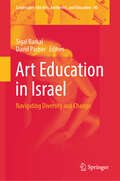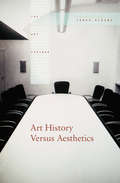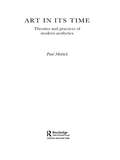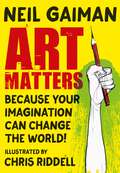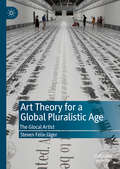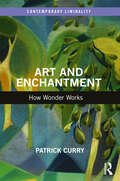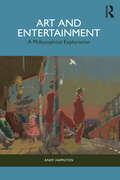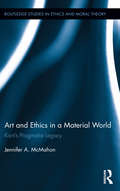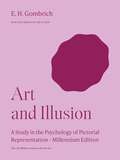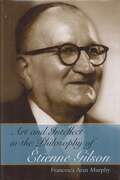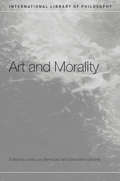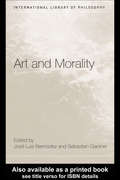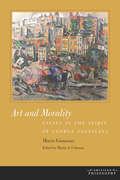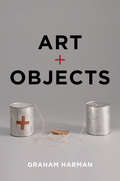- Table View
- List View
Art Education in Israel: Navigating Diversity and Change (Landscapes: the Arts, Aesthetics, and Education #40)
by Sigal Barkai David PariserThis book describes unique aspects of the education system in Israel, specifically focusing on art education, and its role in fostering social change and diversity. It delves into art-based research, autobiographical methodologies, and interviews, showcasing the transformative potential of qualitative research in capturing authentic experiences and promoting social engagement through art education. It shows how practitioner-researchers navigate the complexities of art education, shaping and refining their teaching methodologies to effectively meet the needs of their students. By exhibiting viewpoints from secular and religious Jewish-Israelis, Palestinian citizens of Israel, as well as diverse gender and ethnic communities within Israeli society, it encapsulates the vibrant texture of the country's educational landscape. It also highlights the actions of women as educators and activists who resist oppression wherever it may exist. The book demonstrates a multifaceted perspective on the potential for healing that can be harnessed through art education within specific societal and contextual settings. This vision can be applied and adapted to various other locations worldwide. This book offers rich descriptions of the concerns and dynamics that characterize Israeli art education projects, as a model for other places around the world dealing with similar issues of ethnic and national diversity, political conflicts, violent extremism, and migration. It is beneficial to readers who aim to improve social dimensions such as recognizing a diversity of cultures and developing innovation in teaching methods, with art education as the catalyst.
Art History Versus Aesthetics (The Art Seminar #Vol. 1)
by James ElkinsIn this unprecedented collection, over twenty of the world's most prominent thinkers on the subject including Arthur Danto, Stephen Melville, Wendy Steiner, Alexander Nehamas, and Jay Bernstein ponder the disconnect between these two disciplines. The volume has a radically innovative structure: it begins with introductions, and centres on an animated conversation among ten historians and aestheticians. That conversation was then sent to twenty scholars for commentary and their responses are very diverse: some are informal letters and others full essays with footnotes. Some think they have the answer in hand, and others raise yet more questions. The volume ends with two synoptic essays, one by a prominent aesthetician and the other by a literary critic. This stimulating inaugural volume in the Routledge The Art Seminar series presents not one but many answers to the question; Does philosophy have anything to say to art history?
Art In Its Time: Theories and Practices of Modern Aesthetics
by Paul MattickArt In Its Time takes a close look at the way in which art has become integral to the everyday 'ordinary' life of modern society. It explores the prevalent notion of art as transcending its historical moment, and argues that art cannot be separated from the everyday as it often provides material to represent social struggles and class, to explore sexuality, and to think about modern industry and our economic relationships.
Art Inspiring Transmutations of Life (Analecta Husserliana #106)
by Patricia Trutty CoohillAlthough the creative impulse surges in revolt against everyday reality, breaking through its confines, it makes pacts with that reality's essential laws and returns to it to modulate its sense. In fact, it is through praxis that imagination and artistic inventiveness transmute the vital concerns of life, giving them human measure. But at the same time art's inspiration imbues life with aesthetic sense, which lifts human experience to the spiritual. Within these two perspectives art launches messages of specifically human inner propulsions, strivings, ideals, nostalgia, yearnings prosaic and poetic, profane and sacral, practical and ideal, while standing at the fragile borderline of everydayness and imaginative adventure. Art's creative perduring constructs are intentional marks of the aesthetic significance attributed to the flux of human life and reflect the human quest for repose. They mediate communication and participation in spirit and sustain the relative continuity of culture and history.
Art Matters: Because Your Imagination Can Change the World
by Neil GaimanA creative call to arms from the mind of Neil Gaiman. Art Matters will inspire its readers to seize the day in the name of art. 'Like a bedtime story for the rest of your life, this is a book to live by. At its core, it's about freeing ideas, shedding fear of failure, and learning that "things can be different". ' - Institute of Imagination Be bold. Be rebellious. Choose art. It matters.Neil Gaiman once said that 'the world always seems brighter when you've just made something that wasn't there before'. This little book is the embodiment of that vision. Drawn together from speeches, poems and creative manifestos, Art Matters explores how reading, imagining and creating can change the world, and will be inspirational to young and old. What readers are saying about ART MATTERS 'A rallying cry for all artists and creators' 'Just the injection of positive thinking I needed' 'What a gorgeous, sweet and very, very wise little book' 'You don't know it yet, but it's likely you need this book' 'I feel artistically charged up for the first time in ages'(P)2018 HarperCollins Publishers
Art Matters: Because Your Imagination Can Change the World
by Neil GaimanSeize the day in the name of art. This creative call to arms from the mind of Neil Gaiman combines his extraordinary words with deft and striking illustrations by Chris Riddell. 'Like a bedtime story for the rest of your life, this is a book to live by. At its core, it's about freeing ideas, shedding fear of failure, and learning that "things can be different" ' INSTITUTE OF IMAGINATION Be bold. Be rebellious. Choose art. It matters.Neil Gaiman once said that 'the world always seems brighter when you've just made something that wasn't there before'. This little book is the embodiment of that vision. Drawn together from speeches, poems and creative manifestos, Art Matters explores how reading, imagining and creating can change the world, and will be inspirational to young and old.THIS PAPERBACK EDITION INCLUDES BEAUTIFUL NEW ILLUSTRATIONS OF 'GOING WODWO'. What readers are saying about ART MATTERS 'A rallying cry for all artists and creators' 'Just the injection of positive thinking I needed' 'What a gorgeous, sweet and very, very wise little book' 'You don't know it yet, but it's likely you need this book''I feel artistically charged up for the first time in ages'
Art Music: Love, Listening and Soulfulness
by Matthew Del NevoListening to music is not merely something one does, but something central to a way of living. Listening has the power to transport one into another way of being. It is a mode of feeling and forms the bedrock of deep emotion. Written from the viewpoint of a philosophy of sensibility, Matthew Del Nevo notes that this perspective may not be in fashion, but it follows a long tradition.Del Nevo emphasizes the aesthetic experience of listening to art music as it has developed and disintegrated in Western civilization. He recognizes a deep psychological element to what he calls soul—or more accurately sensibility. He addresses music in a non-technical way, taking up the powerful art theory of Charles Baudelaire, the music philosophy of Schopenhauer and Richard Wagner, and takes a strong critical stand against modernist intellectual art music.The importance of this book for the musically- literate reader is its insight into the metaphysics of nostalgia. This comprehension is missing from nearly all musical instruction because we have lost sight of it. Del Nevo asserts that this understanding must be brought back into our culture. And since this is a book about listening to art music, it is no less about sensibility and its cultivation, which in its object form we call culture. An engaging book, Art Music will appeal to those interested in music, culture, and philosophy.
Art Theory for a Global Pluralistic Age: The Glocal Artist
by Steven Félix-JägerThis book extends a theory of art that addresses the present era’s shift towards global pluralism. By focusing on extrinsic rather than intrinsic qualities of art, this book helps viewers evaluate art across cultural boundaries. Art can be universally classified by an evaluation of its guiding narrative, and can be understood and judged through hermeneutical methods. Since artists engage culture through various local, transnational, and emerging global narratives, it is difficult to decipher what standards are used for evaluation, and which authoritative body evaluates the work. This book implements a narrative-hermeneutical approach to properly classify an artwork and establish its meaning and value.
Art Theory: A Very Short Introduction
by Cynthia A. FreelandIn today's art world, many strange, even shocking, things qualify as art. In this Very Short Introduction Cynthia Freeland explains why innovation and controversy are valued in the arts, weaving together philosophy and art theory with many fascinating examples. She discusses blood, beauty, culture, money, museums, sex, and politics, clarifying contemporary and historical accounts of the nature, function, and interpretation of the arts. Freeland also propels us into the future by surveying cutting-edge web sites, alongside the latest research on the brain's role in perceiving art. This clear, provocative book engages with the big debates surrounding our responses to art and is an invaluable introduction to anyone interested in thinking about art.
Art Without Borders: A Philosophical Exploration of Art and Humanity
by Ben-Ami ScharfsteinPeople all over the world make art and take pleasure in it, and they have done so for millennia. But acknowledging that art is a universal part of human experience leads us to some big questions: Why does it exist? Why do we enjoy it? And how do the world's different art traditions relate to art and to each other? "Art Without Borders" is an extraordinary exploration of those questions, a profound and personal meditation on the human hunger for art and a dazzling synthesis of the whole range of inquiry into its significance. Esteemed thinker Ben-Ami Scharfstein's encyclopedic erudition is here brought to bear on the full breadth of the world of art. He draws on neuroscience and psychology to understand the way we both perceive and conceive of art, including its resistance to verbal exposition. Continuing in this comparative vein, Scharfstein examines the mutual influence of European and non-European artists. Then, through a comprehensive evaluation of the world's major art cultures, he shows how all of these individual traditions are gradually, but haltingly, conjoining into a single current of universal art. Finally, he concludes by looking at the ways empathy and intuition can allow members of one culture to appreciate the art of another. Lucid, learned, and incomparably rich in thought and detail, "Art Without Borders" is a monumental accomplishment, on par with the artistic achievements Scharfstein writes about so lovingly in its pages.
Art and Answerability
by M. M. BakhtinThis book contains three of Bakhtin's early essays from the years following the Russian Revolution, when Bakhtin and other intellectuals eagerly participated in the debates of the period.
Art and Cosmotechnics (e-flux)
by Yuk HuiIn light of current discourses on AI and robotics, what do the various experiences of art contribute to the rethinking of technology today?Art and Cosmotechnics addresses the challenge of technology to the existence of art and traditional thought, especially in light of current discourses on artificial intelligence and robotics. It carries out an attempt on the cosmotechnics of Chinese landscape painting in order to address this question, and further asks: What is the significance of shanshui (mountain and water) in face of the new challenges brought about by the current technological transformation? Thinking art and cosmotechnics together is an attempt to look into the varieties of experiences of art and to ask what these experiences might contribute to the rethinking of technology today.
Art and Creativity in Reggio Emilia: Exploring the Role and Potential of Ateliers in Early Childhood Education (Contesting Early Childhood)
by Vea VecchiThis book explores the contribution of and art and creativity to early education, and examines the role of the atelier (an arts workshop in a school) and atelierista (an educator with an arts background) in the pioneering pre-schools of Reggio Emilia. It does so through the unique experience of Vea Vecchi, one of the first atelieristas to be appointed in Reggio Emilia in 1970. Part memoir, part conversation and part reflection, the book provides a unique insider perspective on the pedagogical work of this extraordinary local project, which continues to be a source of inspiration to early childhood practitioners and policy makers worldwide. Vea’s writing, full of beautiful examples, draws the reader in as she explains the history of the atelier and the evolving role of the atelierista. Key themes of the book include: • processes of learning and knowledge construction • the theory of the hundred languages of childhood and the role of poetic languages • the importance of organisation, ways of working and tools, in particular pedagogical documentation • the vital contribution of the physical environment • the relationship between the atelier, the atelierista, the school and its teachers This enlightening book is essential reading for students, practitioners, policy makers and researchers in early childhood education, and also for all those in other fields of education interested in the relationship between the arts and learning.
Art and Enchantment: How Wonder Works (Contemporary Liminality)
by Patrick CurryThis book concerns the experience of enchantment in art. Considering the essential characteristics, dynamics and conditions of the experience of enchantment in relation to art, including liminality, it offers studies of different kinds of artistic experience and activity, including painting, music, fiction and poetry, before exploring the possibility of a life oriented to enchantment as the activity of art itself. With attention to the complex relationship between wonder in art and the programmatic disenchantment to which it is often subject, the author draws on the thought of a diverse range of philosophers, sociological theorists and artists, to offer an understanding of art through the idea of enchantment, and enchantment through art. An accessible study, richly illustrated with experience – both that of the author and others – Art and Enchantment will appeal to scholars and students of sociology, anthropology, philosophy, and anyone with interests in the nature of aesthetic experience.
Art and Entertainment: A Philosophical Exploration
by Andy HamiltonPhilosophers have discussed art – or artistic practices such as poetry – since ancient times. But systems of art and entertainment appeared only in the modern era – in the West, during the 18th and 19th centuries. And philosophers have largely neglected the concept of entertainment. In this book Andy Hamilton explores art and entertainment from a philosophical standpoint. He argues, against modernist theory, that art and entertainment are not opposites, but form a loosely connected conceptual system. Against postmodernism, however, he insists on their vital differences.Hamilton begins by questioning the received modernist view, examining artist-entertainers including Jane Austen, Charles Dickens, Louis Armstrong and Billie Holiday. Entertainment, he argues, is by nature audience-centred – but so is art, in a different way. Thus while art should pass the test of time, entertainment must pass the test of its own time – it has to entertain at the time it is produced. Art and entertainment are inter-dependent concepts, and must be understood together with other aesthetic concepts including criticism, genius, canons and design. These concepts form the subject of later chapters of this book, where Hamilton develops a meritocratic position that is neither elitist nor populist. He also addresses the contemporary charge of cultural appropriation, and qualifies it.An innovative feature of the book is the inclusion of dialogues with artists, critics and academics that help to recast or reformulate the debate. Art and Entertainment: A Philosophical Exploration is essential reading for those working in art and aesthetics, and will also be of interest to those in related disciplines such as cultural studies, music and film studies, with an interest in entertainment.
Art and Ethics in a Material World: Kant’s Pragmatist Legacy (Routledge Studies in Ethics and Moral Theory)
by Jennifer A McMahonIn this book, McMahon argues that a reading of Kant’s body of work in the light of a pragmatist theory of meaning and language (which arguably is a Kantian legacy) leads one to put community reception ahead of individual reception in the order of aesthetic relations. A core premise of the book is that neo-pragmatism draws attention to an otherwise overlooked aspect of Kant’s "Critique of Aesthetic Judgment," and this is the conception of community which it sets forth. While offering an interpretation of Kant’s aesthetic theory, the book focuses on the implications of Kant’s third critique for contemporary art. McMahon draws upon Kant and his legacy in pragmatist theories of meaning and language to argue that aesthetic judgment is a version of moral judgment: a way to cultivate attitudes conducive to community, which plays a pivotal role in the evolution of language, meaning, and knowledge.
Art and Illusion: A Study in the Psychology of Pictorial Representation - Millennium Edition (The A. W. Mellon Lectures in the Fine Arts #5)
by E. H. GombrichA groundbreaking account of perception and art, from one of the twentieth century’s most important art historiansE. H. Gombrich is widely considered to be one of the most influential art historians of the twentieth century, and Art and Illusion is generally agreed to be his most important book. Bridging science and the humanities, this classic work examines the history and psychology of pictorial representation in light of modern theories of information and learning in visual perception. Searching for a rational explanation of the changing styles of art, Gombrich reexamines ideas about the imitation of nature and the function of tradition. In testing his arguments, he ranges over the history of art, from the ancient Greeks, Leonardo, and Rembrandt to the impressionists and the cubists. But the triumphant originality of Art and Illusion is that Gombrich is less concerned with the artists than with the psychological experience of the viewers of their work.Please note: All images in this ebook are presented in black and white and have been reduced in size.
Art and Intellect in the Philosophy of Étienne Gilson (The Eric Voegelin Institute Series in Political Philosophy #Volume One)
by Francesca Aran MurphyIn Art and Intellect in the Philosophy of Étienne Gilson, Francesca Aran Murphy tells the story of this French philosopher’s struggle to reconcile faith and reason. In his lifetime, Gilson often stood alone in presenting Saint Thomas Aquinas as a theologian, one whose philosophy came from his faith. Today, Gilson’s view is becoming the prevalent one. Murphy provides us with an intellectual biography of this Thomist leader throughout the stages of his scholarly development. <p><p>Murphy covers more than a half century of Gilson’s life while reminding readers of the political and social realities that confronted intellectuals of the early twentieth century. She shows the effects inner-church politics had on Gilson and his contemporaries such as Alfred Loisy, Lucien Lévy Bruhl, Charles Maurras, Henri de Lubac, Marie-Dominique Chenu, and Jacques Maritain, while also contextualizing Gilson’s own life and thoughts in relation to these philosophers and theologians. <p><p>These great thinkers, along with Gilson, continue to be sources of important intellectual debate among scholars, as do the political periods through which Gilson’s story threads—World Wars I and II, the rise and fall of Fascism, and the political upheavals of Europe. By placing Gilson’s twentieth-century Catholic life against a dramatic background of opposed political allegiances, clashing spiritualities, and warring ideas of philosophy, this book shows how rival factions each used their own interpretations of Thomas Aquinas to legitimate their conceptions of the Catholic Church. <p><p>In Art and Intellect in the Philosophy of Étienne Gilson, Murphy shows Gilson’s early openness to the artistic revolution of the Cubist and the Expressionist movements and how his love of art inspired his existential theology. She demonstrates the influence that Henri Bergson continued to have on Gilson and how Gilson tried to bring together the intellectual, Dominican side of Christianity with the charismatic, experiential Franciscan side. <p><p>Murphy concludes with a chapter on issues inspired by the Gilsonist tradition as developed by recent thinkers. This volume makes an original contribution to the study of Gilson, for the first time providing an organic and synthetic treatment of this major spiritual philosopher of modern times.
Art and Its Significance: An Anthology of Aesthetic Theory, Third Edition
by Stephen David RossThis anthology has been significantly expanded for this edition to include a wider range of contemporary issues. The most important addition is a new section on multicultural theory, including important and controversial selections ranging from discussions of art in other cultures to discussions of the appropriation of nonWestern art in Western cultures.The material from Kant's Critique of Judgment has been expanded to include his writing on aesthetical ideas and the sublime. The selections from Derrida have been updated and considerably expanded for this edition, primarily from The Truth in Painting. One of Derrida's most interesting provocations has also been added, his letter to Peter Eisenman on architecture. In addition, the section on feminist theory now includes a chapter from Irigaray's Speculum of the Other Woman.The anthology includes the most important writings on the theory of art in the Western tradition, including selections from Plato, Aristotle, Hume, Kant, Hegel, and Nietzsche; the most important philosophical writings of the last hundred years on the theory of art, including selections from Collingwood, Langer, Goodman, Heidegger, and Merleau-Ponty; contemporary Continental writings on art and interpretation, including selections from Gadamer, Ricoeur, Derrida, Lyotard, and Foucault; also writings on the psychology of art by Freud and Jung, from the Frankfurt School by Benjamin, Adorno, and Marcuse, in feminist theory, multiculturalism, and postmodernism. The anthology also includes twentieth-century writings by artists including discussions of futurism, suprematism, and conceptual art.Stephen David Ross is Professor of Philosophy and Comparative Literature, State University of New York at Binghamton.
Art and Knowledge
by James O. YoungAlmost all of us would agree that the experience of art is deeply rewarding. Why this is the case remains a puzzle; nor does it explain why many of us find works of art much more important than other sources of pleasure. Art and Knowledge argues that the experience of art is so rewarding because it can be an important source of knowledge about ourselves and our relation to each other and to the world. The view that art is a source of knowledge can be traced as far back as Aristotle and Horace. Artists as various as Tasso, Sidney, Henry James and Mendelssohn have believed that art contributes to knowledge. As attractive as this view may be, it has never been satisfactorily defended, either by artists or philosophers. Art and Knowledge reflects on the essence of art and argues that it ought to provide insight as well as pleasure. It argues that all the arts, including music, are importantly representational. This kind of representation is fundamentally different from that found in the sciences, but it can provide insights as important and profound as available from the sciences. Once we recognise that works of art can contribute to knowledge we can avoid thorough relativism about aesthetic value and we can be in a position to evaluate the avant-garde art of the past 100 years. Art and Knowledge is an exceptionally clear and interesting, as well as controversial, exploration of what art is and why it is valuable. It will be of interest to all philosophers of art, artists and art critics.
Art and Liberation: Collected Papers of Herbert Marcuse, Volume 4 (Herbert Marcuse: Collected Papers #4)
by Herbert MarcuseThe role of art in Marcuse’s work has often been neglected, misinterpreted or underplayed. His critics accused him of a religion of art and aesthetics that leads to an escape from politics and society. Yet, as this volume demonstrates, Marcuse analyzes culture and art in the context of how it produces forces of domination and resistance in society, and his writings on culture and art generate the possibility of liberation and radical social transformation. The material in this volume is a rich collection of many of Marcuse’s published and unpublished writings, interviews and talks, including ‘Lyric Poetry after Auschwitz’, reflections on Proust, and Letters on Surrealism; a poem by Samuel Beckett for Marcuse’s eightieth birthday with exchange of letters; and many articles that explore the role of art in society and how it provides possibilities for liberation. This volume will be of interest to those new to Marcuse, generally acknowledged as a major figure in the intellectual and social milieus of the 1960s and 1970s, as well as to the specialist, giving access to a wealth of material from the Marcuse Archive in Frankfurt and his private collection in San Diego, some of it published here in English for the first time. A comprehensive introduction by Douglas Kellner reflects on the genesis, development, and tensions within Marcuse’s aesthetic, while an afterword by Gerhard Schweppenhäuser summarizes their relevance for the contemporary era.
Art and Morality (International Library Of Philosophy Ser.)
by Sebastian GardnerFeaturing contributions from Matthew Kieran, Aaron Ridley, Roger Scruton and Mary Mothersill to name but a few, this collection of groundbreaking new papers on aesthetics and ethics, highlights the link between the two subjects. These leading figures tackle the important questions that arise when one thinks about the moral dimensions of art and the aesthetic dimension of moral life.The volume is a significant contribution to philosophical literature, opening up unexplored questions and shedding new light on more traditional debates in aesthetics. The topics explored include:the relation of aesthetic to ethical judgment the relation of artistic experience to moral consciousnessthe moral status of fictionthe concepts of sentimentality and decadencethe moral dimension of critical practice, pictorial art and musicthe moral significance of tragedythe connections between artistic and moral issues elaborated in the writings of central figures in modern philosophy, such as Kant, Schopenhauer and Nietzsche.The contributors share the view that progress in aesthetics requires detailed study of the practice of criticism. This volume will appeal to both the philosophical community and to researchers in areas such as literary theory, musicology and the theory of art.
Art and Morality (International Library of Philosophy)
by José Luis Bermúdez Sebastian GardnerArt and Morality is a collection of groundbreaking new papers on the theme of aesthetics and ethics, and the link between the two subjects. A group of distinguished contributors tackle the important questions that arise when one thinks about the moral dimensions of art and the aesthetic dimension of moral life.The volume is a significant contribution to philosophical literature, opening up unexplored questions and shedding new light on more traditional debates in aesthetics. The topics explored include: the relation of aesthetic to ethical judgement; the relation of artistic experience to moral consciousness; the moral status of fiction; the concepts of sentimentality and decadence; the moral dimension of critical practice, pictorial art and music; the moral significance of tragedy; and the connections between artistic and moral issues elaborated in the writings of central figures in modern philosophy, such as Kant, Schopenhauer and Nietzsche. The contributors share the view that progress in aesthetics requires detailed study of the practice of criticism. This volume will appeal both to the philosophical community and to researchers in areas such as literary theory, musicology and the theory of art.
Art and Morality: Essays in the Spirit of George Santayana (American Philosophy)
by Morris Grossman Martin A. ColemanThe guiding theme of these essays by aesthetician, musician, and Santayana scholar Morris Grossman is the importance of preserving the tension between what can be unified and what is disorganized, random, and miscellaneous. Grossman described this as the tension between art and morality: Art arrests a sense of change and yields moments of unguarded enjoyment and peace; but soon, shifting circumstances compel evaluation, decision, and action. According to Grossman, the best art preserves the tension between the aesthetic consummation of experience and the press of morality understood as the business of navigating conflicts, making choices, and meeting needs.This concern was intimately related to his reading of George Santayana. The best philosophy, like the best art, preserves the tension between what can be ordered and what resists assimilation, and Grossman read Santayana as exemplifying this virtue in his embrace of multiple perspectives. Other scholars have noted the multiplicity or irony in Santayana’s work, but Grossman was unique in taking such a style to be a substantive part of Santayana’s philosophizing.
Art and Objects
by Graham HarmanIn this book, the founder of object-oriented ontology develops his view that aesthetics is the central discipline of philosophy. Whereas science must attempt to grasp an object in terms of its observable qualities, philosophy and art cannot proceed in this way because they don't have direct access to their objects. Hence philosophy shares the same fate as art in being compelled to communicate indirectly, allusively, or elliptically, rather than in the clear propositional terms that are often taken – wrongly – to be the sole stuff of genuine philosophy. Conceiving of philosophy and art in this way allows us to reread key debates in aesthetic theory and to view art history in a different way. The formalist criticism of Greenberg and Fried is rejected for its refusal to embrace the innate theatricality and deep multiplicity of every artwork. This has consequences for art criticism, making pictorial content more important than formalism thinks but less entwined with the social sphere than anti-formalism holds. It has consequences for art history too, as the surrealists, David, and Poussin, among others, gain in importance. The close link between aesthetics and ontology also invites a new periodization of modern philosophy as a whole, and the habitual turn away from Kant’s thing-in-itself towards an increase in philosophical "immanence" is shown to be a false dawn. This major work will be of great interest to students and scholars of philosophy, aesthetics, art history and cultural theory.
